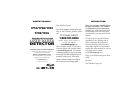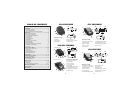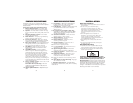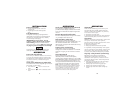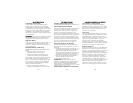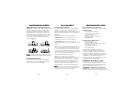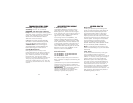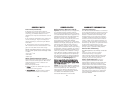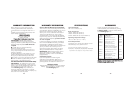
PROBLEM: Unit gives laser alert when
accelerating. See F. A. Q. on website.
PROBLEM: Unit alarms when vehicle hits
bumps. Check for loose lighter socket; tighten
and clean. Check connections at both ends of
power cord. Substitute another cord to
determine if cord is defective. Return
defective cor
d to the factory.
If difficulties occur which cannot be solved by
information in this Troubleshooting Guide,
please call Whistler Customer Service at
1-800-531-0004 or visit our FAQ page at
www.whistlergroup.com/faq-detectors.asp
before returning your unit for service.
Care & Maintenance
During the summer months, avoid
prolonged exposure to direct sunlight by
removing your unit from the dash when
your vehicle is parked for an extended
period of time. Do not spray water,
cleaners, or polishes directly onto the unit.
The spray may penetrate through the
openings and damage the unit. Also, do
not use any abrasive cleaners on the units
exterior.
In Most States YES!
Laser-Radar detectors are legal in every
state (with the exception of Virginia and
Washington, D.C., which have local regula-
tions restricting the use of radar receivers in
any vehicle) when used in automobiles or
light trucks (under 10,000 lbs.).
Concerning trucks over 10,000 lbs., the
Federal Highway Administration (FHWA)
issued a regulation, effective January, 1994
which prohibits radar and laser detector use
in these types of vehicles nationally. Prior to
the FHWA regulation, laws existed in the
state of New York restricting the use of radar
detectors in trucks over 18,000 lbs. and in
Illinois in trucks over 26,000 lbs.
FCC Information
FCC ID HSXWH01 - 1710/1730/1732/1733
FCC ID HSXWH10 - 1710/1730/1732/1733
FCC ID HSXWH14 - 1734
This device complies with part 15 of the FCC
Rules. Operation is subject to the following two
conditions:
(1) This device may not cause harmful interference.
(2) This device must accept any interference
received, including interference that may cause
undesired operation.
IMPORTANT:
FCC requirements state that
changes or modifications not expressly
approved by Whistler could void the user’s
authority to operate the equipment.
TROUBLESHOOTING GUIDE
ARE DETECTORS LEGAL?
17
SPEED FACTS
Radar Facts
A radar gun operates by transmitting radio
waves at certain frequencies which reflect off
objects and are then picked up by the radar
gun’s receiving section. When a radar beam
reflects off a moving target, a measurable
frequency shift occurs. The radar unit converts
this shift into miles per hour to determine your
vehicle’s speed. Currently, the FCC (Federal
Communications Commission) permits
operation of traffic radar guns at X Band
(10.500 - 10.550 GHz), K Band (24.050 - 24.250
GHz), and Ka Band (33.400 - 36.000 GHz).
Note:
A radar detector will not alarm if an
officer is not transmitting on any one of the above
radar bands.
Laser Facts
It’s well documented that many radar guns
cannot reliably provide the speed of a
targeted vehicle that is traveling in a group of
vehicles. In contrast, a laser gun can tar
get a
specific vehicle out of a line of traffic and
determine its speed. The advantage of laser
over radar in terms of target identification is
the result of the laser gun’s narrow beam. A
radar transmission can cover more than a
four-lane highway at a distance of 1,000 feet,
compared with a laser transmission which
covers about 3 feet at the same distance. For
best protection, keep these points, listed on
the following section, in mind:
18
19



